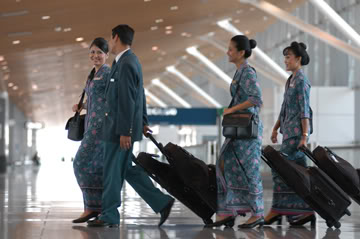The word ergonomics derived from the Greek words, ergon (work) and nomos (natural laws) which means “fit the job to worker”; that work, equipment and the environment should be suitable for workers. Ergonomics accounts for all physical aspects of a person such as body measurement, fitness, strength and posture and the psychological aspects such as mental abilities, personalities, knowledge and experience to carry out their work.
In most of the airline industry, the common ergonomic problems are those associated with manual handling which includes lifting and carrying, pushing and pulling, restraining an object, supporting a weight and even throwing or dropping something into a receptacle. Some ergonomic problems arise from handling various sizes and shapes of cargo items, heavy equipment and spares during aircraft maintenance, awkward posture while answering phone calls, using computers, during serving of passengers on board aircraft. Cargo and traffic handlers, engineers, technicians, ticketing, reservation and flight attendants are some of the categories of staff who are at risk of ergonomic injuries.
Some of the ergonomic problems faced by flight attendants include closing and opening of the aircraft doors; pulling, pushing and restraining the meal cart, loading and unloading hand luggage from the overhead stowage compartment and arranging the meal tray in the galley which involves bending, twisting, repetitive motion and the use of excessive force. This may result in physical injuries and accidents for example slip, trips, falls and musculoskeletal diseases (MSDs).
MSDs can develop as a result of an injury to tendons, ligaments, joints, nerves, and blood vessels. Areas of the body affected include the back, neck, shoulders, arms, elbows, wrist and fingers. The common complains associated with MSDs are discomfort, pain or swelling of the affected joint or muscle and tingling sensation, numbness or weakness when a nerve is involved. This will result in the worker not able to work and causes absenteeism, incur high medical costs and even psychosocial problems such as low morale. Performance and productivity will be compromised. Therefore, application of ergonomic principles is needed to reduce accidents, injuries and illnesses at the workplace.
Some of the steps to be taken to reduce the ergonomics problems are:
- To identify hazard/risk factors in the workplace
- To communicate with the employees and their views in solving the ergonomic issues
- Efficient and effective reporting or notification system
- Workplace design, tools and equipments
- Maintenance of equipment e.g., meal cart wheel, aircraft entry door, Unit Load Device (ULD) container, cargo rollers.
- Health education
- Ergonomic training and awareness
- Regular exercise
The Occupational Safety and Health Act 1994 states that an employer must ensure the work and the working environment is safe for their workers and the employee to cooperate with the employers in all aspects of safety and health in the workplace.
Good ergonomics sense makes good economic sense.
This article is written by Dr. Mohd Suhaimi Yaakof and co-written by Dr. Lim Jac Fang.
[This article belongs to The Malaysian Medical Gazette. Any republication (online or offline) without written permission from The Malaysian Medical Gazette is prohibited.]

